ASUS E35M1-M Pro Review - Anyone For Fusion?
by Brendan van Varik on October 25, 2011 5:00 AM EST- Posted in
- Asus
- Motherboards
- Fusion
- E-350
LAN Speed Test
LAN Speed Test is a freeware program designed for testing the network connection between two PCs on a home network. The speed of the transfer is limited by the lowest common denominator on the network, so if you have gigabit Ethernet capable computers but a 100 Mbit capable router, you are limited to 100 Mbit transfer. Note that this is really a formality – if a network port is rated at 1 Gbps, then chances are that it will hit at least 90+% of this value. The main test here is CPU usage, and how much is offloaded by the controller. For this test, we use LAN Speed Test to transfer a 1000 MB file across a home network with a 1000 Mbps lowest common speed to the same machine each time, in a read/write scenario.
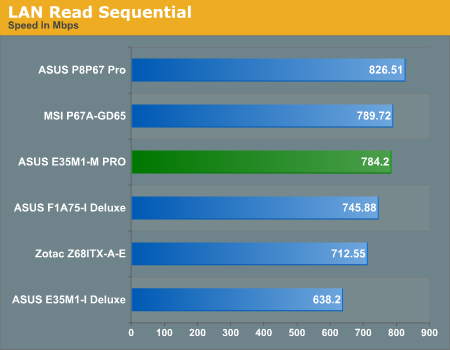
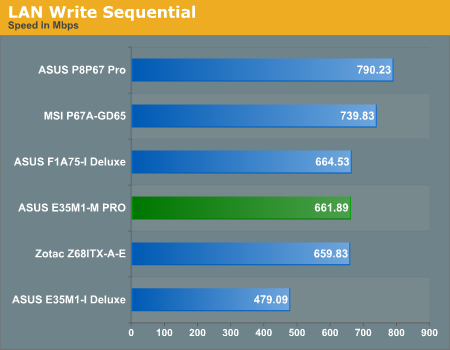
As we only have two results on the A50M platform which were tested under a 1 Gbps environment, I have decided to compare it to a few other platforms too. LAN throughput should be down to the onboard chip and therefore it has been compared to these platforms. Judging by the read and write speeds, the E35M1-M Pro does well for itself and is above average in the read tests but falls just under the average marker with the write tests.
USB Speed
For this benchmark, we run CrystalDiskMark to determine the ideal sequential read and write speeds for the USB port using our 64GB Patriot SuperSpeed USB 3.0 drive. Then we transfer a set size of files from the SSD to the USB drive, and monitor the time taken to transfer. The files transferred are a 1.52 GB set of 2867 files across 320 folders – 95% of these files are small typical website files, and the rest (90% of the size) are the videos used in the Sorenson Squeeze test.

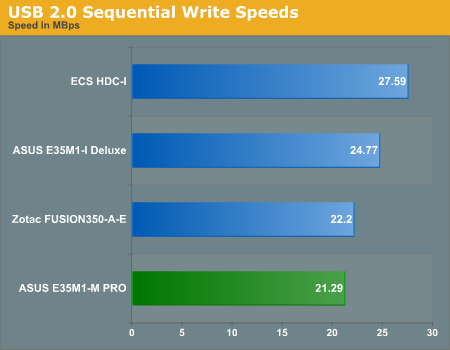
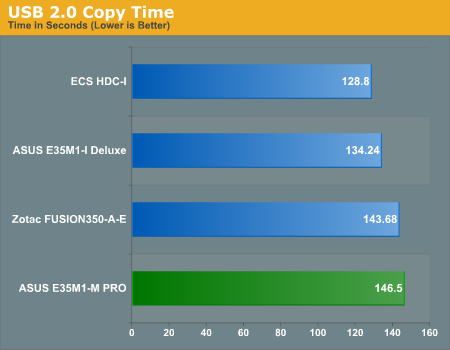
The USB 2.0 read speeds are above average out of the four boards but the writes on the other hand come in at bottom place. The reason for this is unknown.
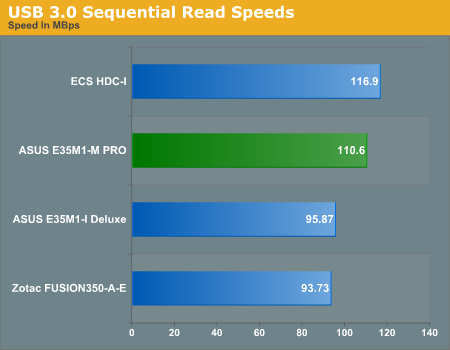

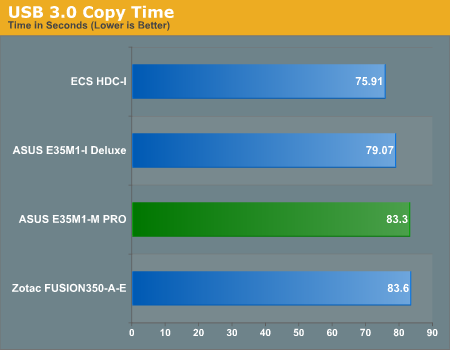
Write speeds on the USB 3.0 side of things are much better than the USB 2.0 results and the read speeds are above average here as well.
SATA Testing
We also use CrystalDiskMark for SATA port testing. The operating system is installed on the OCZ Vertex 3 240GB SSD, which is rated at up to 550 MB/s read and up to 520 MB/s write, and the sequential test is run at the 5 x 1000 MB level on a separate clean partition. This test probes the efficiency of the data delivery system between the chipset and the drive, or in the case of additional SATA ports provided by a third party controller, the efficiency between the controller, the chipset and the drive.


In the Vertex 3 testing the board got the fastest read speeds for A50M but the write speeds were below average. It is debatable whether a user would notice this is regular usage for this board, however.
DPC Latency
Deferred Procedure Call latency is a way in which Windows handles interrupt servicing. In order to wait for a processor to acknowledge the request, the system will queue all interrupt requests by priority. Critical interrupts will be handled as soon as possible, whereas lesser priority requests, such as audio, will be further down the line. So if the audio device requires data, it will have to wait until the request is processed before the buffer is filled. If the device drivers of higher priority components in a system are poorly implemented, this can cause delays in request scheduling and process time, resulting in an empty audio buffer – this leads to characteristic audible pauses, pops and clicks. Having a bigger buffer and correctly implemented system drivers obviously helps in this regard. The DPC latency checker measures how much time is processing DPCs from driver invocation – the lower the value will result in better audio transfer at smaller buffer sizes. Results are measured in microseconds and taken as the peak latency while cycling through a series of short HD videos - under 500 microseconds usually gets the green light, but the lower the better.

The E35M1-M PRO currently holds the lowest DPC Latency score in our records for the A50M platform.










66 Comments
View All Comments
C300fans - Tuesday, October 25, 2011 - link
1, If DXVA 2.0 works FLAWLESSLY , it works.2, It is good.
spaceyyeti - Tuesday, October 25, 2011 - link
1. Yes, it can. Even 1080p flash (on windows) is kidsplay for fusion.2. Way better then Intel's. I run linux and I get some glitches, but those are really really rare. Under windows there are no problems at all.
C300fans - Tuesday, October 25, 2011 - link
2, If you use cpu to decode high rate files, it will have obivous glitches.spaceyyeti - Tuesday, October 25, 2011 - link
it's not a cpu problem. the ati linux drivers are not that great lately, so uvd3 support is still a bit problematic. but as I said; the glitches are rare. some movies get none, others get 1 or 2 in an hour. they are not annoying or even that noticeable. and yes, I checked my codecs :-) the main problem with the ati drivers nowadays is bad support for gnome-shell/gnome 3. artifacts al over the place. haha. but that's not really relevant to this article.plonk420 - Wednesday, October 26, 2011 - link
it's not high bitrates that have issues, it's retarded settings that go out of Level 4.1 specs, like 16 reference frames @ 1080p.i just wish this was ~20-30% faster and 1/4th the GPU speed. it's just ever so slightly too slow for Spline scaling in ffdshow, IIRC.
Meegulthwarp - Tuesday, October 25, 2011 - link
Nice to see a power supply that reflects what most people would be using with this setup. It would be interesting to have a comparison between this 250w and a 1000w to see if all the haters were correct.Once again, nice review. Currently looking for a HTPC for my new flat. Just worried AMD might release a refresh of Fusion when I buy one. Anyone know if there is a refresh on the horizon?
spaceyyeti - Tuesday, October 25, 2011 - link
The E-450 is coming. Higher CPU and GPU clockspeeds (cpu: 1,65ghz gpu: 508mhz with 600mhz turbo) and a better memory controller supporting 1333mhz. But you can do that with this board too, by just selecting it in the bios.Other than that, you'll probably have to wait for a process shrink.
http://www.anandtech.com/show/4407/the-brazos-upda...
Meegulthwarp - Tuesday, October 25, 2011 - link
Thanks, I thought I saw that but couldn't find it. Might just mull it over and give the E-350 a pass for the time being.lestr - Tuesday, October 25, 2011 - link
Ancient history folks. Asus has updated to the 450. Boards have been available in Asia and Europe for weeks now. Slight bump to 1.65 and RAM std upped to 1333, OC 1600. No idea how it would test out - hasn't been done yet. Can't understand why they only have 3 analog audio outs on the rear. BIOS tweaks? who knows.I sent an e-mail to Anand 2 weeks go asking him to get Gary to send one over... Oh well.. we'll see who gets it first. Nice try and a good re-introduction.
silverblue - Tuesday, October 25, 2011 - link
I'm very interested to see if the extra memory bandwidth does anything for the HD 6320 or if it runs out of steam, in which case AMD would've been right to only include a single channel memory interface.